Maximizing Value in Constructed Wetlands: A Review of Ornamental Plants for Wastewater Treatment and Artisanal Applications
Abstract
1. Introduction
2. Materials and Methods
3. Results and Discussions
3.1. Description of Treatment Wetlands and Their Importance in Wastewater Purification
3.2. Ornamental Plants and Their Role in Constructed Wetlands
3.3. Bibliometric Analysis of the Use of Wastewater Treatment with Ornamental Plants and Case Studies
| Study Site | Wastewater Treated | Plants Used | CW Area (m2) | Removal (%) | Reference |
|---|---|---|---|---|---|
| Palmas de Abajo, Actopan, Veracruz | Community | Sansevieria zeylanica, Typha angustifolia, Cyperus (alternifolius, papyrus), Canna hybrid, Heliconia psittacorum. | 300 | TN: 56 TP: 72 COD: 90 | Marín-Muñiz et al. [64] |
| Nautla, Veracruz | Municipal wastewater | Sansevieria trifasciata, Canna (indica, hybrids), Colocasia esculenta, Pontederia cordata, Heliconia psittacorum, Ruellia sp., Sagittaria graminea, Cyperus papyrus, Berberis thunbergii. | 430 | COD: 93 N-NO3: 92 N-NH4: 93 TN: 91 | Sangabriel et al. [65] |
| Veracruz | Swine | Typha angustifolia, Canna hybrids | 100 | COD: 84, TSS: 82, TN: 94, TP: 82 | Sandoval-Herazo et al. [66] |
| Salvador Diaz Miron, Misantla, Veracruz | Community | Alocasia odora, Hedychium coronarium, Heliconia psittacorum, Zantedeschia aethiopica, Canna indica | not specified | TN: 40 TP: 68 COD: 93 | Monzón-Reyes et al. [67] |
| Pastorías, Actopan, Veracruz | Community | Typha sp., Canna hybrids, Anturium sp., Sphathiphylum blandum | 70 | COD: 84 TS: 90 | Sandoval et al. [68] |
| Pinoltepec, Emiliano Zapata, Veracruz | Community | Typha sp., Zantedeschia aethiopica., Hedychium coronarium. Thalia sp. | 60 | TN: 47 TP: 33 COD: 67 | Hernández [47] |
| Chapala, Jalisco, México | Community | Canna hybrids and Strelitzia reginae | 70 | COD: 86 TN: 30–33 TP: 24–44 | Merino-Solís et al. [54] |
| San Juan de Aragón, Gustavo A. Madero. México | Eutrophic lake | Phragmites australis., Equisetum hyemale y Cyperus papyrus | 1613 | BOD: 88 TN: 72 TP: 50 | Luna-Pabello y Aburto-Castañeda, [69] |
| Santa Fe de la Laguna, Quiroga, Michoacán | Municipal | Phragmites australis, Typha latifolia | 8800 | BOD: 94–98 COD: 91–93 TS: 91–97 TN: 56–88 | Rivas et al. [70] |
| University UAM Xochimilco, México. | Municipal | Arundo donax, Medicago sativa y Zandechia aethiopica | 55 | COD: 92 N-NH4: 85% P-PO4: 80% | Ramírez-Carrillo et al. [71] |
| UAM-Azcapotzalco. Mexico City | Municipal | Phragmites australis, Typha latifolia | 200 | BOD: 80 | Barceló et al. [72] |
| Cucuchucho, Tzintzuntzan, Michoacán | Community | Phragmites australis, Typha latifolia y Zantedeschia aethiopica | 3265 Sumado a otros 7 sistemas | BOD: 89 TN: 80 TP: 74 | González and Rivas [73] |
| Area “Instituto Tecnológico de Boca del Río, Veracruz” | University | Alpinia purpurata., Ruellia brottoniana., Canna hybrids., Cyperus papyrus., Heliconia pisittacorum., Pennisetum setaceumy and others ND. | 157 | TN: >70 TP: >70 COD: 15 | Lango et al. [74] |
| Felipe carrillo Puerto, Tapachula, Chiapas | Domestic | Heliconia psittacorum., Alpinia purpurata, Typha domingensis | 110 | COD: 64 BOD: 50 TN: 30–39 TP: 44 | Méndez-Mendoza et al. [15] |
| Argovia, Tapachula, Chiapas. | Wet coffee processing | Saccharum spp., Panicum máximum., Heliconia psittacorum., Vetiveria zizanoides y Clorophytum conmutatum | 300 | COD: 91 Coliforms: 93 | Orozco et al. [75] |
| Erongarícuaro, Michoacán | Municipal | Phragmites communis, Typha latifolia | 11,600 | BOD: 70–9 COD: 70–90 | Sánchez-Chávez et al. [76] |
3.4. Utilization of Ornamental Plants in Constructed Wetlands
4. Conclusions
Author Contributions
Funding
Institutional Review Board Statement
Informed Consent Statement
Data Availability Statement
Acknowledgments
Conflicts of Interest
References
- United Nations Framework Convention on Climate Change. Paris Agreement. 2015. Available online: https://unfccc.int/sites/default/files/english_paris_agreement.pdf (accessed on 7 May 2025).
- Bose, D.; Bhattacharya, R.; Kaur, T.; Banerjee, R.; Bhatia, T.; Ray, A.; Mondal, A.; Ghosh, P.; Monda, S. Overcoming water, sanitation, and hygiene challenges in critical regions of the global community. Water-Energy Nexus 2024, 7, 7277–7296. [Google Scholar] [CrossRef]
- Abney, S.E.; Bright, K.R.; McKinney, J.; Khalid, M.; Gerba, C.P. Toiled hygiene-review and research needs. J. Appl. Microbiol. 2021, 131, 2705–2714. [Google Scholar] [CrossRef] [PubMed]
- Mojiri, A. Treatment of Water and Wastewater: Challenges and Solutions. Separations 2023, 10, 385. [Google Scholar] [CrossRef]
- Johnson, H.; South, N.; Walters, R. The commodification and exploitation of fresh water: Property, human rights and green criminology. Int. J. Law. Crime. Justice 2016, 44, 146–162. [Google Scholar] [CrossRef]
- UN Habitat; WHO. Progress on Wastewater Treatment—Global Status and Acceleration Needs for SDG Indicator 6.3.1; United Nations Human Settlements Programme (UN-Habitat): Geneva, Switzerland; World Health Organization (WHO): Geneva, Switzerland, 2021. [Google Scholar]
- Silva, J.A. Wastewater Treatment and Reuse for Sustainable Water Resources Management: A Systematic Literature Review. Sustainability 2023, 15, 10940. [Google Scholar] [CrossRef]
- Kama, R.; Song, J.; Liu, Y.; Hamani, A.K.M.; Zhao, S.; Li, Z. Water Availability and Status of Wastewater Treatment and Agriculture Reuse in China: A Review. Agronomy 2023, 13, 1187. [Google Scholar] [CrossRef]
- Molinos-Senante, M.; Gómez, T.; Garrido-Baserba, M.; Caballero, R.; Sala-Garrido, R. Assessing the sustainability of small wastewater treatment systems: A composite indicator approach. Sci. Total Environ. 2014, 497–498, 607–617. [Google Scholar] [CrossRef]
- Parde, D.; Patwa, A.; Shukla, A.; Vijay, R.; Killedar, D.; Kumar, R. A review of constructed wetland on type, treatment and technology of wastewater. Envion Technol. Innov. 2021, 21, 101261. [Google Scholar] [CrossRef]
- Vymazal, J. Plants used in constructed wetlands with horizontal subsurface flow: A review. Hydrobiologia 2011, 674, 133–156. [Google Scholar] [CrossRef]
- Vymazal, J. Emergent plant used in free water surface constructed wetlands: A review. Ecol. Eng. 2013, 61, 582–592. [Google Scholar] [CrossRef]
- Li, J.; Zheng, B.; Chen, X.; Li, Z.; Xia, Q.; Wang, H.; Yang, Y.; Zhou, Y.; Yang, H. The Use of Constructed Wetland for Mitigating Nitrogen and Phosphorus from Agricultural Runoff: A Review. Water 2021, 13, 476. [Google Scholar] [CrossRef]
- Hernández, M.E.; Marín-Muñiz, J.L. Greenhouse gas emissions and treatment performance in constructed wetlands with ornamental plants: Case Studies in Veracruz, Mexico. In Artificial or Constructed Wetlands a Suitable Technology for Sustainable Water Management; Durán-Domínguez, M., Navarro-Frómeta, A., Bayona, J., Eds.; CRC Press: Boca Raton, FL, USA; Taylor & Francis Group: Abingdon, UK, 2018; pp. 163–177. [Google Scholar]
- Méndez-Mendoza, A.S.; Bello-Mendoza, R.; Herrera-López, D.; Mejía-González, G.; Calixto-Romo, A. Performance of constructed wetlands with ornamental plants in the treatment of domestic wastewater under the tropical climate of South Mexico. Water Pract. Technol. 2015, 10, 110–123. [Google Scholar] [CrossRef]
- Vera-Puerto, I.; Marca, N.; Contreras, C.; Zuñiga, F.; López, J.; Sanguesa, C.; Correo, C.; Arias, C.; Valenzuela, M. Performance of vertical and horizontal treatment wetlands planted with ornamental plants in Central Chile: Comparative analysis of initial operations stage for effluent reuse in agriculture. Env. Sci. Pollut. Res. 2024, 31, 50398–50410. [Google Scholar] [CrossRef] [PubMed]
- Hook, D.; Porter, S.; Herzong, C. Dimensions: Building context for search and evaluation. Front. Res. Metr. Anal. 2018, 3, 23. [Google Scholar] [CrossRef]
- Marín-Muñiz, J.L.; Sandoval, L.C.; López-Méndez, M.C.; Sandoval-Herazo, M.; Meléndez-Armenta, R.Á.; González-Moreno, H.R.; Zamora, S. Treatment wetlands in Mexico for control of wastewater contaminants: A review of experiences during the last twenty-two years. Processes 2023, 11, 359. [Google Scholar] [CrossRef]
- Mitsch, W.J.; Gosselink, J.; Anderson, C.; Fennessy, S. Wetland, 6th ed.; John Wiley and Sons Inc.: New York, NY, USA, 2023. [Google Scholar]
- Masi, F.; Martinuzzi, N. Constructed wetlands for the Mediterranean countries: Hybrid systems for water reuse and sustainable sanitation. Desalination 2007, 215, 44–55. [Google Scholar] [CrossRef]
- Sandoval, L.; Alvarado-Lassman, A.; Marín-Muniz, J.L.; Rodríguez-Miranda, J.P.; Fernández-Lambert, G. A critical review of mineral substrates used as filter media in subsurface constructed wetlands: Costs as a selection criterion. Environ. Technol. Rev. 2023, 12, 251–271. [Google Scholar] [CrossRef]
- Campaña, L.M.V.; Molina, C.R.; Romero, F.C.A. Las potencialidades artesanales. Un análisis desde la perspectiva de desarrollo sostenible para su revalorización y empresarialidad turística. Retos Turísticos 2015, 14, 1–13. [Google Scholar] [CrossRef]
- Zitácuaro-Contreras, I.; Vidal-Álvarez, M.; Hernández y Orduna, M.; Zamora-Castro, S.; Betanzo-Torres, E.; Marín-Muniz, J.; Sandoval-Herazo, L. Environmental, economic, and social potentialities of ornamental vegetation cultivated in constructed wetlands of Mexico. Sustainability 2021, 13, 6267. [Google Scholar] [CrossRef]
- Sánchez-Olivares, E.; Marín-Muniz, J.L.; Hernández-Alarcón, M.E. Liberación de oxígeno radial por las raíces de las plantas nativas de humedales tropicales costeros de Veracruz en respuesta a diferentes condiciones de inundación. Bot. Sci. 2019, 97, 202–210. [Google Scholar] [CrossRef]
- Sorrell, B.K. Effect of external oxygen demand on radial oxygen loss by Juncus roots in titanium citrate solutions. Plant Cell Environ. 1999, 22, 1587–1593. [Google Scholar] [CrossRef]
- Lai, W.; Zhang, Y.; Chen, Z. Radial oxygen loss, photosynthesis, and nutient removal of 35 wetland plants. Ecol. Eng. 2012, 39, 24–30. [Google Scholar] [CrossRef]
- Oliveros-Bastidas, J.; Macías, F.; Carrera, C.; Marín, D.; Molinillo, J. Exudados de la raíz y su relevancia actual en las interacciones alelopáticas. Quim. Nova 2009, 32, 198–213. [Google Scholar] [CrossRef]
- Ma, X.; Du, Y.; Peng, W.; Zhang, S.; Liu, X.; Wang, S.; Yuan, S.; Kolditz, O. Modelling the impacts of plants and internal organic carbon on remediation performance in the integrated vertica flow constructed wetlands. Water Res. 2021, 204, 117635. [Google Scholar] [CrossRef]
- Haviland, K.; Noyce, G. Assessing root-soil interactions in wetland plants: Root exudation and radial oxygen loss. Biogeosciences 2024, 21, 5185–5198. [Google Scholar] [CrossRef]
- Marin, M.; Feeney, D.S.; Brown, L.K.; Naveed, M.; Ruiz, S.; Koebernick, N.; Bengough, A.G.; Hallett, P.D.; Roose, T.; Puértolas, J.; et al. Significance of root hairs for plant performance under contrasting field conditions and water deficit. Ann. Bot. 2021, 128, 1–16. [Google Scholar] [CrossRef]
- Kim, H.; Jang, J.; Seomun, S.; Yoon, Y.; Jang, G. Division of cortical cells is regulated by auxin in Arabidopsis roots. Front. Plant Sci. 2022, 13, 953225. [Google Scholar] [CrossRef]
- Nyainleta, G.; Pesik, A.; Hiariej, A. Epidermal structure and leaf stomata of several accessions of banana plants (Musa spp.). J. Penelit. Pendidik. IPA 2022, 8, 2974–2979. [Google Scholar] [CrossRef]
- Kiri, I. Mechanisms of Nutrient Uptake and Assimilation Processes in Some Plants: A Review. Dutse. J. Pure Appl. Sci. 2023, 9, 223–237. [Google Scholar] [CrossRef]
- Rahman, S.; Qin, A.; Zain, M.; Mushtaq, Z.; Mehmood, F.; Riaz, L.; Naveed, S.; Ansari, M.; Saeed, M.; Ahmad, I.; et al. Pb uptake, accumulation, and translocation in plants: Plants physiological, biochemical, and molecular response: A review. Helyon 2024, 10, e27724. [Google Scholar] [CrossRef]
- Ashraf, A.; Bhardwaj, S.; Ishtiaq, H.; Devi, Y.; Kapoor, D. Lead uptake, toxicity and mitigation strategies in plants. Plant Arch. 2021, 21, 293–294. [Google Scholar] [CrossRef]
- Zhang, C.; Feng, Y.; Liu, Y.; Chang, H.; Li, Z.; Xue, J. Uptake and translocation of organic pollutants in plants: A review. J. Integr. Agric. 2017, 16, 1659–1668. [Google Scholar] [CrossRef]
- Dettenmaier, E.; Doucette, W.; Bugbee, B. Chemical hydrophobicity and uptake by plant roots. Environ. Sci. Tecnol. 2009, 43, 324–329. [Google Scholar] [CrossRef]
- Tejeda, A.; Torres-Bojorges, Á.X.; Zurita, F. Carbamazepine removal in three pilot-scale hybrid wetlands planted with ornamental species. Ecol. Eng. 2017, 98, 410–417. [Google Scholar] [CrossRef]
- Colmer, T.D. Long-Distance Transport of Gases in Plants: A Perspective on Internal Aeration and Radial Oxygen Loss from Roots. Plant Cell Environ. 2003, 26, 17–36. [Google Scholar]
- Jackson, M.B.; Armstrong, W. Formation of Aerenchyma and the Processes of Plant Ventilation in Relation to Soil Flooding and Submergence. Plant Biol. 1999, 1, 274–287. [Google Scholar] [CrossRef]
- Björn, L.O.; Middleton, B.A.; Germ, M.; Gaberščik, A. Ventilation Systems in Wetland Plant Species. Diversity 2022, 14, 517. [Google Scholar] [CrossRef]
- Laan, P.; Berrevoets, M.J.; Lythe, S.; Armstrong, W.; Blom, C.W.P.M. Root Morphology and Aerenchyma Formation as Indicators of the Flood-Tolerance of Rumex Species. J. Ecol. 1989, 77, 693–703. [Google Scholar] [CrossRef]
- Larcher, W. Physiological Plant Ecology: Ecophysiology and Stress Physiology of Functional Groups, 4th ed.; Springer: Berlin, Germany, 2003. [Google Scholar]
- Liu, J.; Zhang, Z.; Yu, Z.; Liang, Y.; Li, X.; Ren, L. The structure and flexural properties of Typha leaves. Appl. Bionics Biomech. 2017, 2017, 1249870. [Google Scholar] [CrossRef]
- Stefanatou, A.; Schiza, S.; Petousi, I.; Rizzo, A.; Masi, F.; Stasinakis, A.; Fyllas, N.; Fountoulakis, M. Use of climbing and ornamental plants in vertical flow constructed wetlands treating greywater. J. Water Proc. Eng. 2023, 53, 103832. [Google Scholar] [CrossRef]
- Garcia-Avila, F.; Aviles-Anazco, A.; Cabello-Torres, R.; Guanuchi-Quito, A.; Cadme-Galabay, M.; Gutierrez-Ortega, H.; Alvarez-Ochoa, R.; Zhindon-Arevalo, C. Application of ornamental plants in constructed wetlands for wastewater treatment: A scientometric analysis. Case Stud. Chem. Environ. Eng. 2023, 7, 100307. [Google Scholar] [CrossRef]
- Hernández, M.E. Humedales ornamentales con participación comunitaria para el saneamiento de aguas municipales en México. Rinderesu 2016, 1, 1–12. (accessed on 5 June 2025). (In Spanish). [Google Scholar]
- Zurita, F.; de Anda, J.; Belmont, M.A. Performance of laboratory-scale wetlands planted with tropical ornamental plants to treat domestic wastewater. Water Qual. Res. J. Can. 2006, 41, 410–417. [Google Scholar] [CrossRef]
- Zurita, F.; De Anda, J.; Belmont, M.A. Treatment of domestic wastewater and production of commercial flowers in vertical and horizontal subsurface-flow constructed wetlands. Ecol. Eng. 2009, 35, 861–869. [Google Scholar] [CrossRef]
- Fernández-Echeverría, E.; Sandoval-Herazo, L.C.; Zurita, F.; Betanzo-Torres, E.; Sandoval-Herazo, M. Development of Heliconia latispatha in constructed wetlands, for the treatment of swine/domestic wastewater in tropical climates, with PET as a substitute for the filter medium. Rev. Mex. Ing. Quím 2022, 21, IA2811. [Google Scholar] [CrossRef]
- Gu, X.; Chen, D.; Wu, F.; He, S.; Huang, J. Recycled utilization of Iris pseudacorus in constructed wetlands: Litters self-consumption and nitrogen removal improvement. Chemosphere 2021, 262, 127863. [Google Scholar] [CrossRef]
- Polomski, R.; Bielemberg, D.; Whitwell, T.; Taylor, M.; Bridges, W.; Klaine, S. Nutrient recovery by seven aquatic garden plants in a laboratory-scale subsurface-constructed wetland. Hort. Sci. 2007, 42, 1674–1680. [Google Scholar] [CrossRef]
- Marín-Muñiz, J.L.; Hernández, M.E.; Gallegos-Pérez, M.P.; Amaya-Tejeda, S.I. Plant growth and pollutant removal from wastewater in domiciliary constructed wetland microcosms with monoculture and polyculture of tropical ornamental plants. Ecol. Eng. 2020, 147, 105658. [Google Scholar] [CrossRef]
- Merino-Solís, M.; Villegas, E.; Anda, J.; López-López, A. The Effect of the hydraulic retention time on the performance of an ecological wastewater treatment system: An anaerobic filter with a constructed wetland. Water 2015, 7, 1149–1163. [Google Scholar] [CrossRef]
- Sinha, S.V.; Argyilan, E.P.; Krekeler, M.P.S. An environmental investigation of the mineralogical, geotechnical, hydrogeologic and botanical properties of subsurface flow constructed wetlands in Akumal Mexico. Environ. Earth Sci. 2014, 73, 2299–2317. [Google Scholar] [CrossRef]
- Almeida-Naranjo, C.; Guachamín, G.; Guerrero, V.; Villamar, C.-A. Heliconia stricta behavior on hybrid constructed wetlands fed with synthetic domestic wastewater. Water 2020, 12, 1373. [Google Scholar] [CrossRef]
- Rivas, R. Elaboración del Diagnóstico del Humedal de Acamixtla, Recomendaciones y Propuesta de Acciones para su Rehabilitación, en la Localidad de Acamixtla Municipio de Taxco de Alarcón, en el Estado de Guerrero. Informe Final. IMTA. 2016. Available online: http://repositorio.imta.mx/handle/20.500.12013/1743 (accessed on 18 May 2025). (In Spanish).
- Zamora-Castro, S.; Marín-Muñiz, J.L.; Sandoval, L.; Vidal-Álvarez, M.; Carrión-Delgado, J. Effect of ornamental plants, seasonality, and filter media material in fill-and-drain constructed wetlands treating rural community wastewater. Sustainability 2019, 11, 2350. [Google Scholar] [CrossRef]
- Cárdenas, D.; Barbosa, G. Uso de humedales artificiales de flujo subsuperficial para postramiento de aguas residuales de la industria textil. Jovenes Cienc. 2015, 1, 1427–1431. Available online: https://www.jovenesenlaciencia.ugto.mx/index.php/jovenesenlaciencia/article/view/98 (accessed on 9 July 2025). (In Spanish).
- Manzano, E.; Hernández-Vásquez, L.A.; Alvarado-Lassman, A.; Sánchez-Valera, O.; Hernández-Salina, G. Zingiber spectabile en humedales artificiales para el tratamiento de aguas residuales y su uso en la agricultura. Cienc. Tecn. Agrop. Mex. 2022, 10, 84–92. Available online: http://www.somecta.org.mx/wp-content/uploads/2022/12/11-Spectabili-tratamiento-agua.pdf (accessed on 9 July 2025). (In Spanish).
- Nani, G.; Sandoval-Herazo, M.; Martínez-Reséndiz, G.; Marín-Pena, O.; Zurita, F.; Sandoval Herazo, L.C. Influence of Bed Depth on the Development of Tropical Ornamental Plants in Subsurface Flow Treatment Wetlands for Municipal Wastewater Treatment: A Pilot-Scale Case. Plants 2024, 13, 1958. [Google Scholar] [CrossRef]
- Tejeda, A.; Zurita, F. Capacity of two ornamental species (Iris sibrica and Zantedeschia aethiopica) to take up, translocate, and accumulate carbamazepine under hydroponic conditions. Water 2020, 12, 1272. [Google Scholar] [CrossRef]
- Bartucca, M.L.; Cerri, M.; Forni, C. Phytoremediation of Pollutants: Applicability and Future Perspective. Plants 2023, 12, 2462. [Google Scholar] [CrossRef]
- Marín-Muñiz, J.L. Humedales Construidos: Un Caso de Éxito en Palmas de Abajo, Actopan, Veracruz, [Virtual Conference]; Secretaría de Finanzas y Planeación del Estado de Veracruz y secretaría de Medio Ambiente: “Conferencias sobre Medio Ambiente” Heroica Veracruz, Mexico, 2025. (In Spanish)
- Lomeli, J.S.; Zamora-Castro, S.A.; Zamora-Lobato, T.; Sandoval-Herazo, E.J.; Adame-Garcia, J.; Zurita, F.; Monroy-Pineda, M.C.; Aguilar-Cortes, G.; Rivera, S.; Sandoval-Herazo, M. Performance of Large-Scale Ornamental Wetlands for Municipal Wastewater Treatment: A Case Study in a Polluted Estuary in the Gulf of Mexico. Sustainability 2025, 17, 2120. [Google Scholar] [CrossRef]
- Sandoval-Herazo, M.; Martínez-Reséndiz, G.; Fernández Echeverria, E.; Fernández-Lambert, G.; Sandoval Herazo, L.C. Plant Biomass Production in Constructed Wetlands Treating Swine Wastewater in Tropical Climates. Fermentation 2021, 7, 296. [Google Scholar] [CrossRef]
- Monzon-Reyes, B.L.; Gonzalez-Moreno, H.R.; Month, A.E.A.; Peralta Vega, A.J.; Ballut-Dajud, G.; Sandoval Herazo, L.C. Wastewater Management Strategies in Rural Communities Using Constructed Wetlands: The Role of Community Participation. Earth 2025, 6, 18. [Google Scholar] [CrossRef]
- Sandoval, L.C.; Marín-Muniz, L.C.; Alvarado-Lassman, A.; Zurita, F.; Marín-Peña, O.; Sandoval-Herazo, M. Full-scale constructed wetlands planted with ornamental species and pet as a substitute for filter media for municipal wastewater treatment: An experience in a Mexican community. Water 2023, 15, 2280. [Google Scholar] [CrossRef]
- Luna-Pabello, V.M.; Aburto-Castañeda, S. Sistema de humedales artificiales para el control de la eutroficación del lago del Bosque de San Juan de Aragón. TIP Rev. Esp. Cienc. Quím-Biol. 2014, 17, 32–55. Available online: https://www.scielo.org.mx/scielo.php?script=sci_arttext&pid=S1405-888X2014000100003 (accessed on 2 May 2025). (In Spanish). [CrossRef]
- Rivas, A.; Barceló-Quintal, I.; Moeller, G.E. Pollutant removal in a multi-stage municipal wastewater treatment system comprised of constructed wetlands and a maturation pond, in a temperate climate. Water Sci. Technol. 2011, 64, 980–988. [Google Scholar] [CrossRef] [PubMed]
- Ramírez-Carrillo, H.F.; Luna-Pabello, V.M.; Arredondo-Figueroa, J.L. Evaluación de un humedal artificial de flujo vertical intermitente, para obtener agua de buena calidad para la acuicultura. Rev. Mex. Ing. Quím 2009, 8, 93–99. Available online: https://www.scielo.org.mx/scielo.php?script=sci_arttext&pid=S1665-27382009000100009 (accessed on 1 May 2025). (In Spanish).
- Barceló, I.D.; Rivas, A.; Solís, H.E.; García, J.; Salazar, M.; Giacomán, G.; Zetina, C. Comportamiento de un sistema humedal-laguna de maduración-humedal de pulimento a nivel piloto para el tratamiento de aguas municipales en la Universidad Autónoma Metropolitana de la unidad Azcapotzalco en la Cd. de México, México. In Book of Abstracts II Panamerican Conference of Wetland Systems for Treatment and Improvement of Water Quality; Hupanam: Morelia, México, 2014; pp. 55–58. Available online: https://hupanam.com/wp-content/uploads/2022/04/Memorias-II-Conferencia-Mexico.pdf (accessed on 1 June 2024). (In Spanish)
- González, C.E.; Rivas, A. Humedales artificiales para el tratamiento de las aguas residuales generadas en áreas rurales ribereñas al lago de Pátzcuaro. Tláloc 2008, 41, 8–13. Available online: https://amh.org.mx/wp-content/uploads/2024/10/TLALOC_41.pdf (accessed on 5 June 2022). (In Spanish).
- Lango, F.; Castañeda, M. Humedal Artificial para Tratamiento de Aguas Residuales del Instituto Tecnológico de Boca del Río: Escalamiento. Informe. 2016. Available online: https://www.aguanet.com.mx/foro21/resumenes/ResumenExt2_3_Lango.pdf (accessed on 2 March 2025). (In Spanish).
- Orozco, C.; Cruz, A.; Rodríguez, M.; Pohlan, A. Humedal subsuperficial de flujo vertical como sistema de depuración terciaria en el proceso de beneficiado de café. Hig. Sanid. Ambient. 2006, 6, 190–196. Available online: https://saludpublica.ugr.es/sites/dpto/spublica/public/inline-files/bc51015a2fc8ef6_Hig.Sanid_.Ambient.6.190-196(2006).pdf (accessed on 1 May 2025). (In Spanish).
- Sánchez-Chávez, J.; Bravo-Inclán, L.; Tomasini-Ortiz, C.; González-Villela, R.; Rivas-Hedez, A. Evolución de humedales de tratamiento en comunidades ribereñas del lago de Pátzcuaro (2006–2011). In Book of Abstracts III Panamerican Conference of Wetland Systems for Treatment and Improvement of Water Quality; Hupanam: Santa Fe, Argentina, 2016; Available online: https://hupanam.com/wp-content/uploads/2022/04/Memorias-III-Conferencia-Argentina.pdf (accessed on 20 February 2025). (In Spanish)
- Liu, T.; Li, D.; Tian, Y.; Zhou, J.; Qiu, Y.; Li, D.; Liu, G.; Feng, Y. Enhancing nitrogen removal in constructed wetlands: The role of influent substrate concentrations in integrated vertical-flow systems. Environ. Sci. Ecotech 2024, 21, 100411. [Google Scholar] [CrossRef]
- Yang, L.; Jin, X.; Hu, Y.; Zhang, M.; Wang, H.; Jia, Q.; Yang, Y. Thecnical structure and influencing factors of nitrogen and phosphorus removal in constructed wetlands. Water Sci. Technol. 2024, 89, 271–289. [Google Scholar] [CrossRef]
- Xu, J.; He, S.; Wu, S.; Huang, J.; Zhou, W.; Chen, W. Effects of HRT and water temperature on nitrogen removal in autotrophic gravel filter. Chemosphere 2016, 147, 203–209. [Google Scholar] [CrossRef]
- Li, P.; Liu, M.; Zhou, J.; Chen, L.; Cai, M. Adsorption performance of different wetland substrates for ammonia nitrogen: An experimental study. Water 2024, 16, 174. [Google Scholar] [CrossRef]
- Borin, M.; Milani, M.; Salvato, M.; Toscano, A. Evaluation of Phragmites australis (Cav.) Trin. evapotranspiration in Northern and Southern Italy. Ecol. Eng. 2011, 37, 721–728. [Google Scholar] [CrossRef]
- Milani, M.; Marzo, A.; Toscano, A.; Consoli, S.; Cirelli, G.; Ventura, D.; Barbagallo, S. Evapotranspiration from horizontal subsurface flow constructed wetlands planted with different perennial plant species. Water 2019, 11, 2159. [Google Scholar] [CrossRef]
- Beebe, D.; Castle, J.; Molz, F.J.; Rodgers, J. Effects of evapotranspration on treatment performance in constructed wetlands: Experimental studies and modeling. Ecol. Eng. 2014, 71, 394–400. [Google Scholar] [CrossRef]
- Chen, G.; Mo, Y.; Gu, X.; Jeppesen, E.; Xie, T.; Ning, Z.; Li, Y.; Chen, C.; Cui, B.; Wu, H. Sustainability of global small-scale constructed wetlands for multiple pollutant control. npj Clean. Water 2024, 7, 45. [Google Scholar] [CrossRef]
- Flores, P.; López, C. Government management of information technlogy in the Latin American context. Salud Cienc. Tecnol. 2024, 3, 682. [Google Scholar] [CrossRef]
- Samuel, W.; Richard, B.; Nyantakyi, J.A. Phytoremediation of heavy metals contaminated water and soils from artisanal mining enclave using Heliconia psittacorum. Model. Earth Syst. Environ. 2022, 8, 591–600. [Google Scholar] [CrossRef]
- Marrugo-Negrete, J.; Enamorado-Montes, G.; Durango-Hernández, J.; Pinedo-Henrández, J.; Díez, S. Removal of mercury from gold mine effluents using Limnocharis flava in constructed wetlands. Chemosphere 2017, 167, 188–192. [Google Scholar] [CrossRef] [PubMed]
- Quevedo, A. Diseño y construcción de humedal artificial para la recuperación de aguas residuales en la población de Alcalá. Rev. Cienc. Tecn. Innov. 2021, 19, 133–148. Available online: https://revistas.usfx.bo/index.php/rcti/article/view/476 (accessed on 2 May 2025). (In Spanish). [CrossRef]
- Zitácuaro, I.; Marín-Muñiz, J.L.; Álvarez-Hernández, L.M. La ciencia, el medio ambiente y la mujer. Colversatorio 2024, 6, 35–40. Available online: https://drive.google.com/file/d/1piFhx_bBFdR3Tal7fvONXp-fW_j9hWaS/view (accessed on 16 March 2025). (In Spanish).
- Flores, M.; Rello, F. Capital Social Rural Experiencias de México y Centroamérica; CEPAL: Santiago, Chile, 2002; Available online: https://www.cepal.org/es/publicaciones/1738-capital-social-rural-experiencias-mexico-centroamerica (accessed on 2 March 2025). (In Spanish)
- Putnam, R.D. The prosperous community. Am. Prospect. 1993, 4, 35–42. Available online: https://prospect.org/infrastructure/prosperous-community-social-capital-public-life/ (accessed on 11 March 2025).
- Bridger, J.C.; Luloff, A.E. Building the Sustainable Community: Is Social Capital the Answer? Sociol. Inq. 2001, 71, 458–472. [Google Scholar] [CrossRef]
- Maldonado, G.; Voeks, R. The Paradox of Culturally Useful Invasive Species: Southern Cattail (Typha domingensis) Crafts of Lake Pátzcuaro, Mexico. J. Lat. Am. Geog 2021, 20, 148–174. Available online: https://www.jstor.org/stable/48650405 (accessed on 10 July 2025). [CrossRef]
- Domínguez-Solís, D.; Martínez-Rodríguez, M.C.; Ramírez Escamilla, H.G.; Campos-Villegas, L.E.; Domínguez-Solís, R. Constructed WetlandsasaDecentralizedTreatment OptionforDomesticWastewater: A Systematic Review (2015–2024). Water 2025, 17, 1451. [Google Scholar] [CrossRef]
- Gorgoglione, A.; Torretta, V. Sustainable management and successful application of constructed wetlands: A critical review. Sustainability 2018, 10, 3910. [Google Scholar] [CrossRef]
- Masoud, A.M.N.; Alfarra, A.; Sorlini, S. Constructed Wetlands as a Solution for Sustainable Sanitation: A Comprehensive Review on Integrating Climate Change Resilience and Circular Economy. Water 2022, 14, 3232. [Google Scholar] [CrossRef]
- Allub, L. Aversión al riesgo y adopción de innovaciones tecnológicas en pequeños productores rurales de zonas áridas: Un enfoque causal. Estud. Sociológicos 2001, 19, 467–493. Available online: https://dialnet.unirioja.es/servlet/articulo?codigo=4469899 (accessed on 7 September 2025). (In Spanish).
- Operacz, A.; Jóźwiakowski, K.; Rodziewicz, J.; Janczukowicz, W.; Bugajski, P. Impact of climate conditions on pollutant concentrations in the effluent from a one-stage constructed wetland: A case study. Sustainability 2023, 15, 13173. [Google Scholar] [CrossRef]
- Knight, R.; Walton, W.; O´Meara, G.; Reisen, W.; Wass, R. Strategies for effective mosquito control in constructed wetlands. Ecol. Eng. 2003, 21, 211–232. [Google Scholar] [CrossRef]
- Wangm, H.; Sheng, L.; Xu, J. Clogging mechanisms of constructed wetlands: A critical review. J. Clean. Prod. 2021, 295, 126455. [Google Scholar] [CrossRef]
- Waly, M.M.; Mickovski, S.B.; Thomson, C.; Amadi, K. Impact of implementing constructed wetlands on supporting the sustainable development goals. Land 2022, 11, 1963. [Google Scholar] [CrossRef]
- Seifollahi-Aghmiuni, S.; Nockrach, M.; Kalantari, Z. The potential of wetlands in achieving the sustainable development goals of the 2030 agenda. Water 2019, 11, 609. [Google Scholar] [CrossRef]
- Hernandez-Crespo, C.; Oliver, N.; Gil-Martinez, E.; Ano, M.; Fernandez-Alba, S.; Benedito, V.; Montoya, T.; Martin, M. Integrating circular economy and biodiversity in upgrading full-scale constructed wetlands (LIFE Renaturwat). Ecol. Eng. 2024, 204, 107263. [Google Scholar] [CrossRef]
- de Campos, S.X.; Soto, M. The Use of Constructed wetlands to treat effluents for water reuse. Environments 2024, 11, 35. [Google Scholar] [CrossRef]
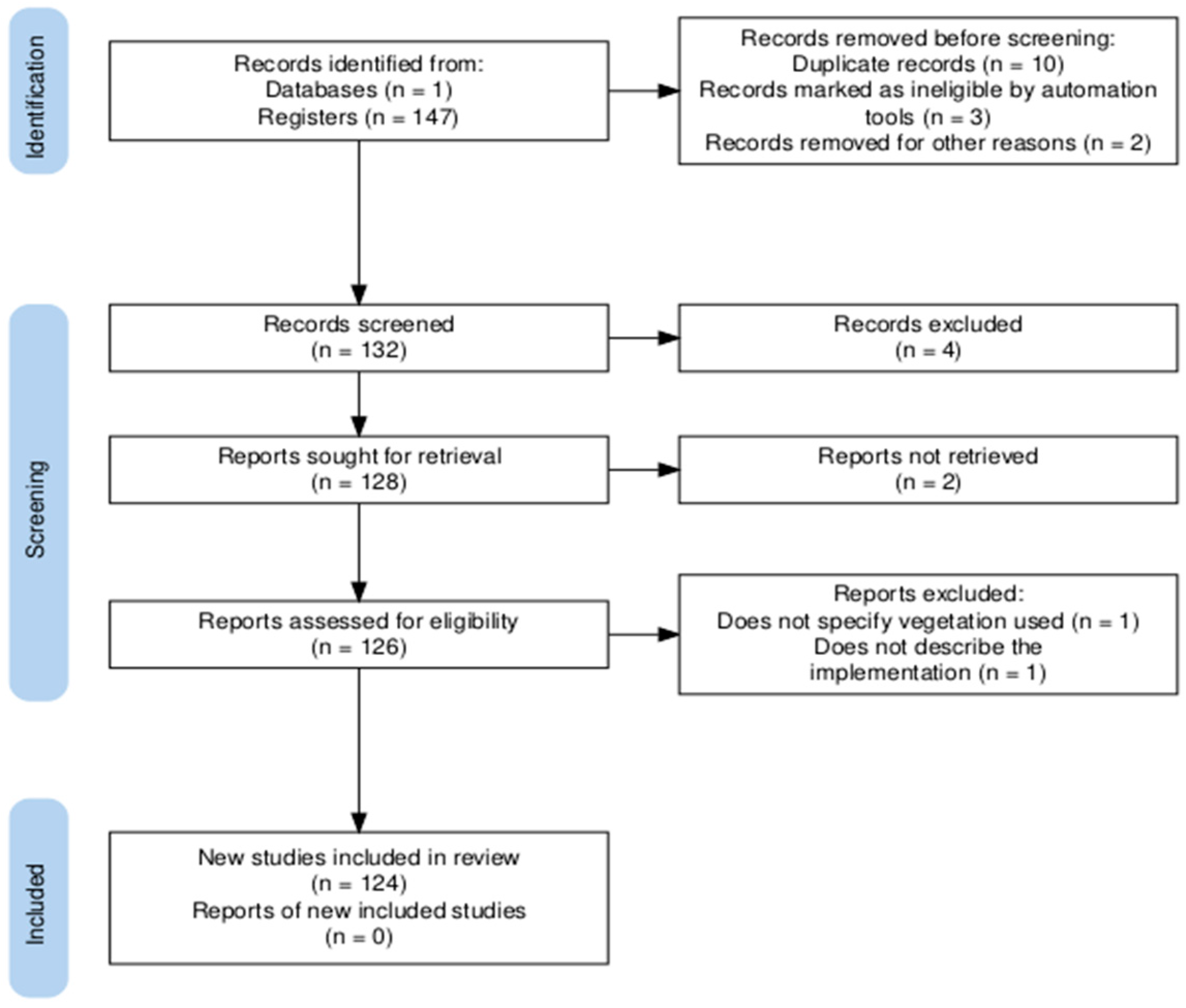

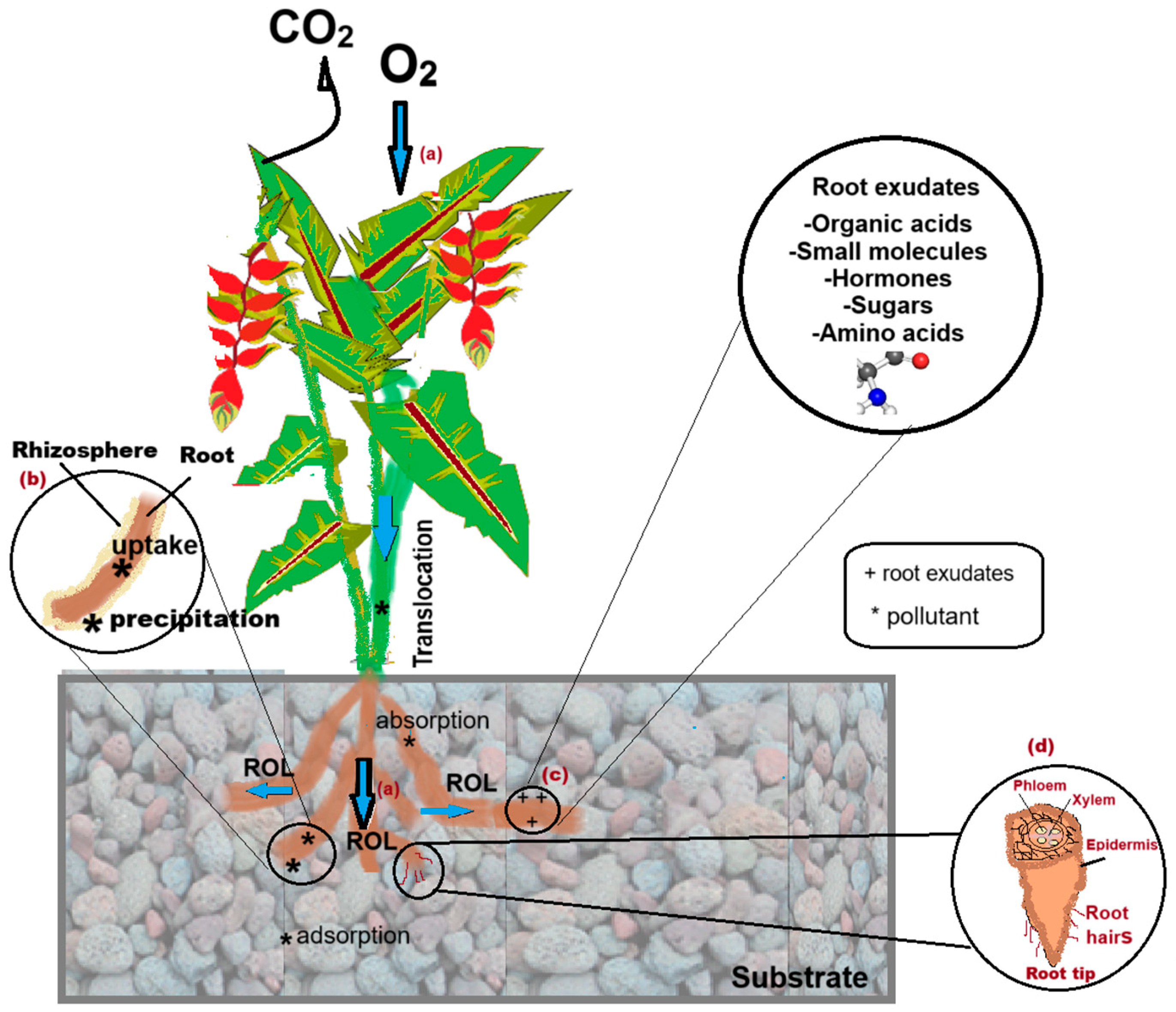
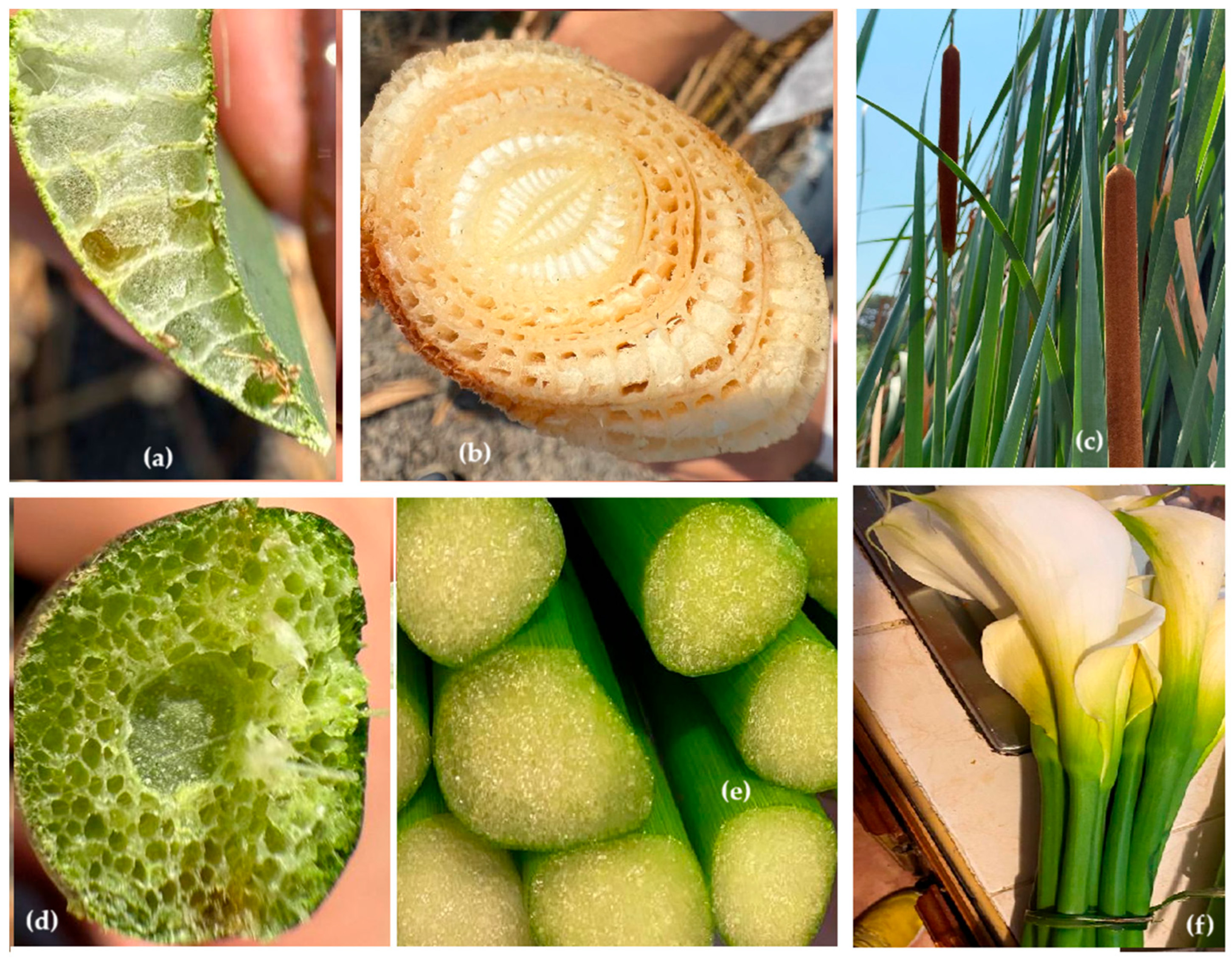
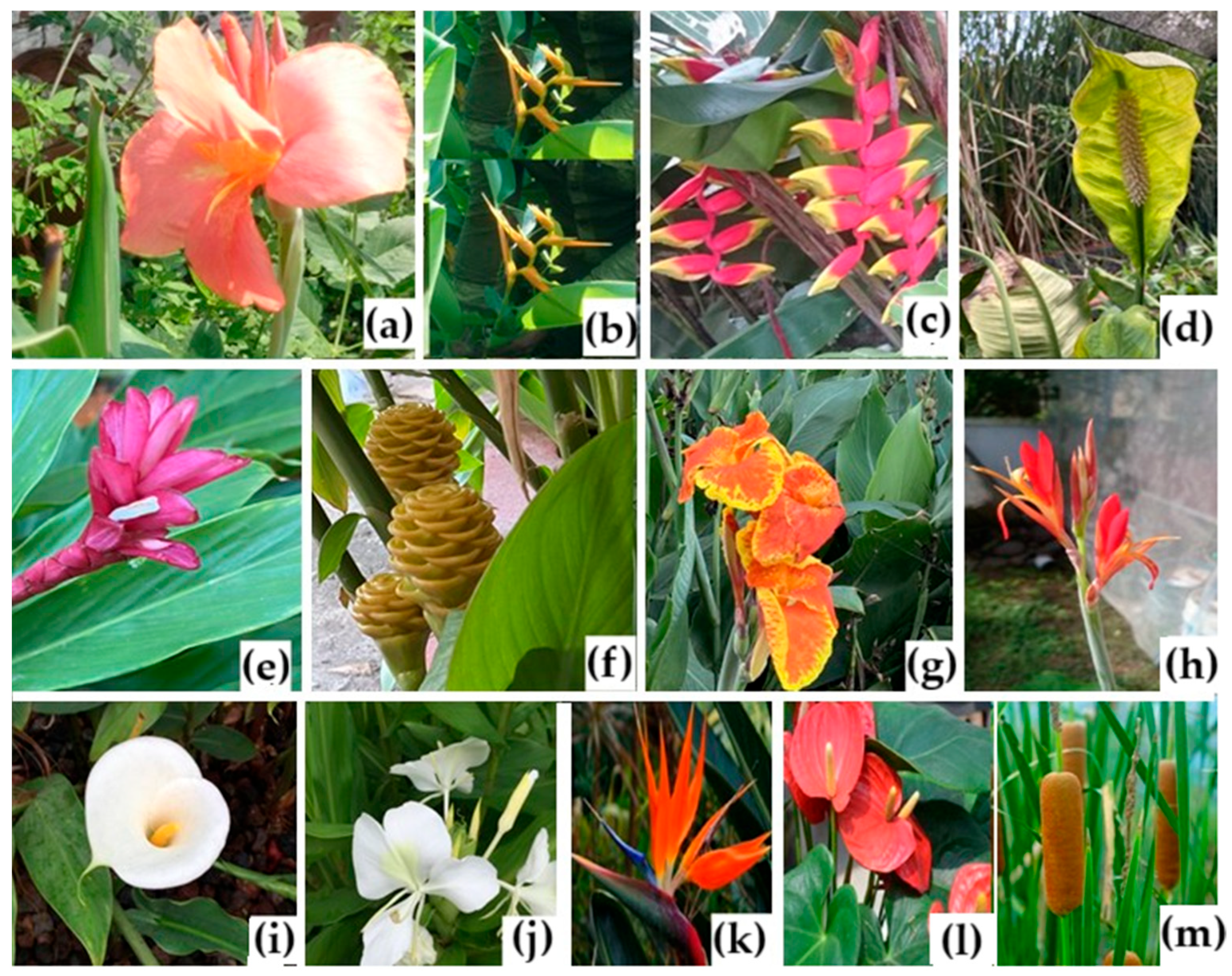
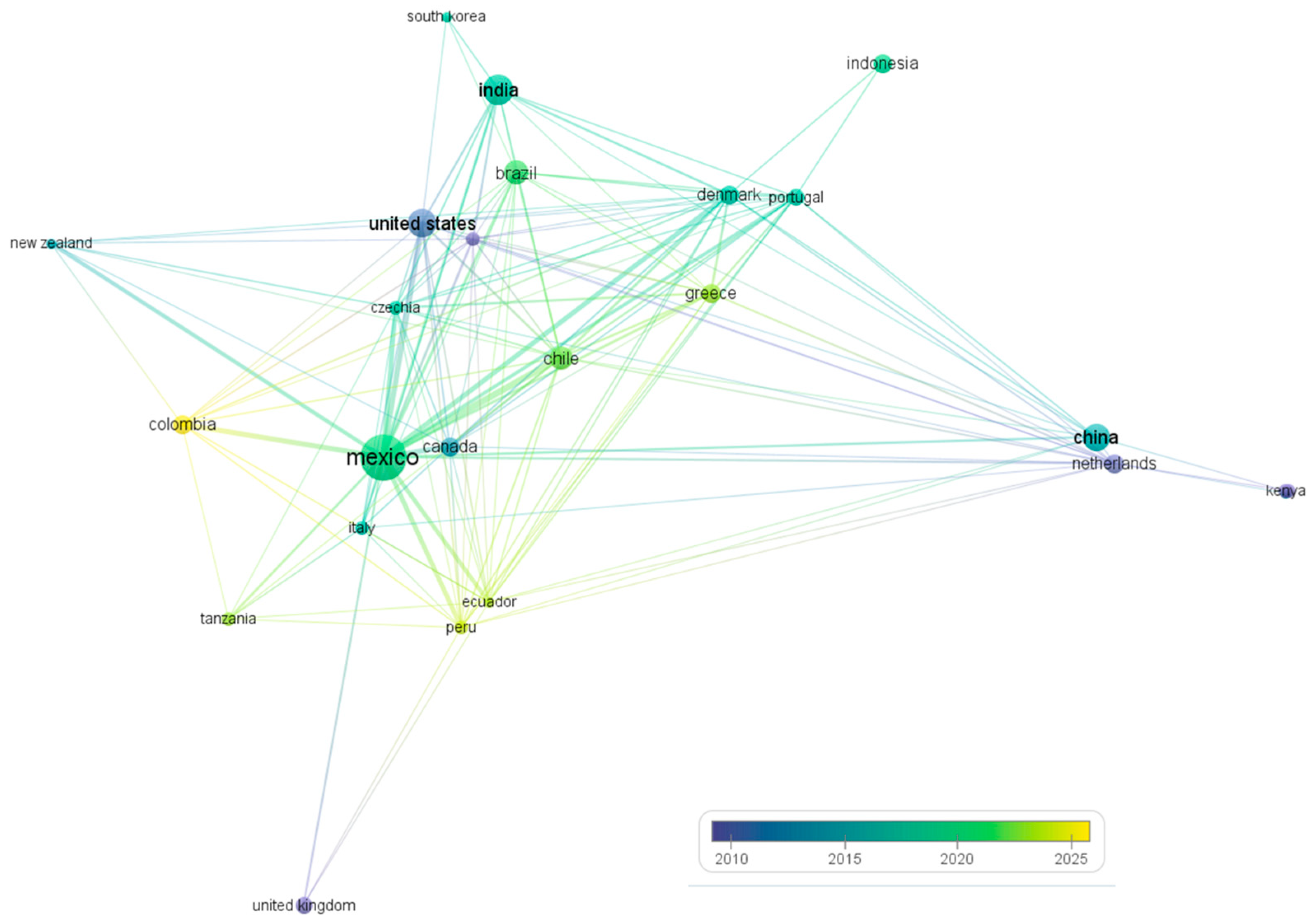
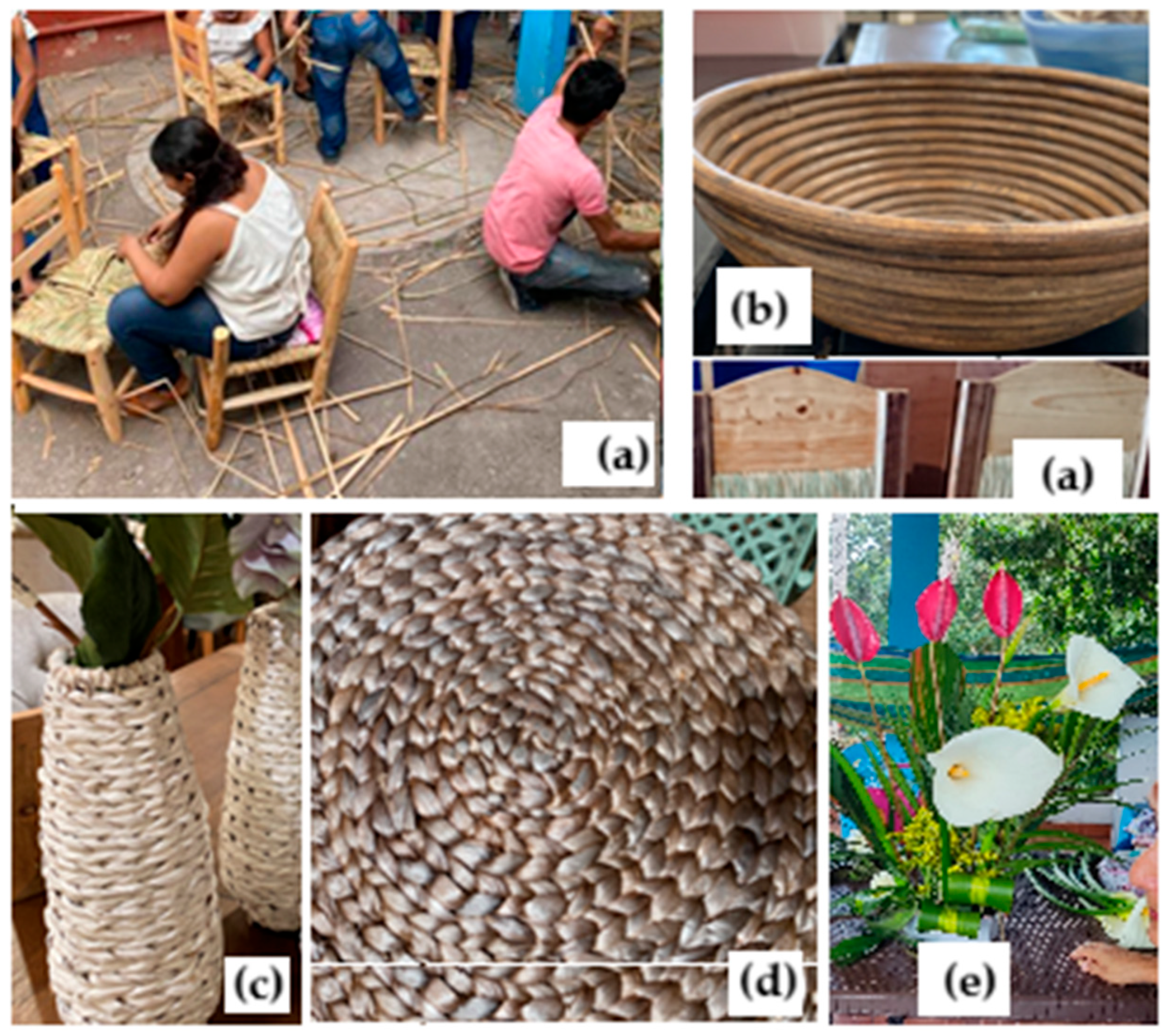
Disclaimer/Publisher’s Note: The statements, opinions and data contained in all publications are solely those of the individual author(s) and contributor(s) and not of MDPI and/or the editor(s). MDPI and/or the editor(s) disclaim responsibility for any injury to people or property resulting from any ideas, methods, instructions or products referred to in the content. |
© 2025 by the authors. Licensee MDPI, Basel, Switzerland. This article is an open access article distributed under the terms and conditions of the Creative Commons Attribution (CC BY) license (https://creativecommons.org/licenses/by/4.0/).
Share and Cite
Zamora-Castro, S.A.; Orduña, M.G.H.y.; Moreno-Seceña, J.C.; Martínez Escalante, G.A.; Sangabriel Lomeli, J.; Zitácuaro-Contreras, I.; Marín-Muñiz, J.L. Maximizing Value in Constructed Wetlands: A Review of Ornamental Plants for Wastewater Treatment and Artisanal Applications. Earth 2025, 6, 126. https://doi.org/10.3390/earth6040126
Zamora-Castro SA, Orduña MGHy, Moreno-Seceña JC, Martínez Escalante GA, Sangabriel Lomeli J, Zitácuaro-Contreras I, Marín-Muñiz JL. Maximizing Value in Constructed Wetlands: A Review of Ornamental Plants for Wastewater Treatment and Artisanal Applications. Earth. 2025; 6(4):126. https://doi.org/10.3390/earth6040126
Chicago/Turabian StyleZamora-Castro, Sergio Aurelio, María Graciela Hernández y Orduña, Juan Carlos Moreno-Seceña, Gustavo Alonso Martínez Escalante, Joaquin Sangabriel Lomeli, Irma Zitácuaro-Contreras, and José Luis Marín-Muñiz. 2025. "Maximizing Value in Constructed Wetlands: A Review of Ornamental Plants for Wastewater Treatment and Artisanal Applications" Earth 6, no. 4: 126. https://doi.org/10.3390/earth6040126
APA StyleZamora-Castro, S. A., Orduña, M. G. H. y., Moreno-Seceña, J. C., Martínez Escalante, G. A., Sangabriel Lomeli, J., Zitácuaro-Contreras, I., & Marín-Muñiz, J. L. (2025). Maximizing Value in Constructed Wetlands: A Review of Ornamental Plants for Wastewater Treatment and Artisanal Applications. Earth, 6(4), 126. https://doi.org/10.3390/earth6040126








